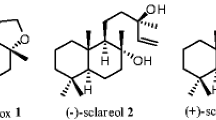Abstract
The biotransformation reactions of α-bromoacetophenone (1), p-bromo-α-bromoacetophenone (2), and p-nitro-α-bromoacetophenone (3) by whole cells of the marine fungus Aspergillus sydowii Ce19 have been investigated. Fungal cells that had been grown in artificial sea water medium containing a high concentration of chloride ions (1.20 M) catalysed the biotransformation of 1 to 2-bromo-1-phenylethanol 4 (56%), together with the α-chlorohydrin 7 (9%), 1-phenylethan-1,2-diol 9 (26%), acetophenone 10 (4%) and phenylethanol 11 (5%) identified by GC-MS analysis. In addition, it was observed that the enzymatic reaction was accompanied by the spontaneous debromination of 1 to yield α-chloroacetophenone 5 (9%) and α-hydroxyacetophenone 6 (18%) identified by GC-FID analysis. When 2 and 3 were employed as substrates, various biotransformation products were detected but the formation of halohydrins was not observed. It is concluded that marine fungus A. sydowii Ce19 presents potential for the biotransformations of bromoacetophenone derivatives.



Similar content being viewed by others
References
Aleixo LM, De Carvalho M, Moran PJS, Rodrigues JAR (1993) Hydride transfer versus electron transfer in the baker’s yeast reduction. Bioorg Med Chem Lett 3:1637–1642
Andrade LH, Polak R, Porto ALM, Schoenlein-Crusius IH, Comasseto JV (2006) Application of bioreduction by microorganisms in the enantioselective synthesis of alpha-substituted-1-phenylethanols. Lett Org Chem 3:613–618
Antunes H, Fardelone LC, Rodrigues JAR, Moran PJS (2004) Chemoenzymatic syntheses of (R)-2-bromo-, (R)-2-chloro- and (R)-2-azido-1-(1, 3-benzodioxol-5-yl)-1-ethanol. Tetrahedron Asymmetr 15:2615–2620
Assis LF, Kagohara E, Omori AT, Comasseto JV, Andrade LH, Porto ALM (2007) Deracemisation of (RS)-1-[4-methylselanyl)phenyl]ethanol and (RS)-1-[(4-ethylselanyl)phenyl]ethanol by strains of Aspergillus terreus. Food Technol Biotechnol 45:415–419
Basavaiah D, Rao KV, Reddy BS (2006) (2S)-2-Anilinomethylpyrrolidine: an efficient in situ recyclable chiral catalytic source for the borane-mediated asymmetric reduction of prochiral ketones in refluxing toluene. Tetrahedron Asymmetr 17:1041–1044
Basavaiah D, Rao KV, Reddy BS (2007) (5S)-1-Aza-2-imino-3oxa-4, 4-diphenylbicyclo[3.30]octane: a novel chiral catalytic source containing the N–(C═NH)–O moiety for the borane-mediated asymmetric reduction of prochiral ketones. Tetrahedron Asymmetr 18:963–967
Cagnon JR, Porto ALM, Marsaioli AJ, Manfio GP, Eguchi SY (1999) First evaluation of the Brazilian microorganisms biocatalytic potential. Chemosphere 38:2237–2242
Chartrain M, Greasham R, Moore J, Reider P, Robinson D, Buckland B (2002) Asymmetric bioreductions: application to the synthesis of pharmaceuticals. J Mol Catal B: Enzymatic 11:503–512
De Carvalho M, Okamoto MT, Moran PJS, Rodrigues JAR (1991) Baker’s yeast reduction of α-haloacetophenones. Tetrahedron 47:2073–2080
Goldberg S, Schroer K, Lutz S, Liese A (2007) Biocatalytic ketone reduction—a powerful tool for the production of chiral alcohols—part II: whole cell reductions. Appl Microbiol Biotechnol 76:249–255
Goswami A, Bezbaruah RL, Goswami J, Borthakur N, Dey D, Hazarika AK (2000) Microbial reduction of ω-bromoacetophenones in the presence of surfactants. Tetrahedron Asymmetr 11:3701–3709
Goswami A, Mirfakhrae KD, Totleben MJ, Swaminathan S, Patel RN (2001) Microbial reduction of α-chloroketone to α-chlorohydrin. J Ind Microbiol Biotechnol 26:259–262
Lagos FM, Carballeira JD, Bermúdez JL, Alvarez E, Sinisterra JV (2004) Highly stereoselective reduction of haloketones using three new yeasts: application to the synthesis of (S)-adrenergic β-blockers related to propranolol. Tetrahedron Asymmetr 15:763–770
Patel RM, Banerjee A, Chu L, Brozozowski NV, Szarka LJ (1998) Microbial synthesis of chiral intermediates for β-receptor agonists. J Am Oil Chem Soc 75:1473–1482
Pavia DL, Lampman GM, Kriz GS, Engel RG (1999) Introduction to organic laboratory techniques, 3rd edn. Sunders College Publishing, Orlando
Piovan L, Capelari M, Andrade LH, Comasseto JV, Porto ALM (2007) Biocatalytic reduction of a racemic selenocyclohexanone by Brazilian basidiomycetes. Tetrahedron Asymmetr 18:1398–1402
Rocha LC (2008) Reduction of acetophenones by marine-derived fungi. PhD Thesis. University of São Paulo, São Carlos, SP, Brazil
Rocha LC, Ferreira HV, Pimenta EF, Berlinck RGS, Seleghim MHR, Javaroti DCD, Sette LD, Bonugli RC, Porto ALM (2009) Bioreduction of α-chloroacetophenone by whole cells of marine fungi. Biotechnol Lett. doi:10.1007/s10529-009-0037-y
Rodrigues JAR, Moran PJS, Conceição JJA, Fardelone LC (2004) Recent advances in the biocatalytic asymmetric reduction of acetophenones and αβ-unsaturated carbonyl compounds. Food Technol Biotechnol 42:295–303
Smolen JM, Weber EJ, Tratnyek PG (1999) Molecular probe techniques for the identification of reductants in sediments: evidence for reduction of 2-chloroacetophenone by hydride transfer. Environ Sci Technol 33:440–445
Wei Z-L, Li Z-Y, Li G-Q (1998) anti-Prelog microbial reduction of aryl α-halomethyl or α-hydroxymethyl ketones with geotrichum sp 38. Tetrahedron 54:13059–13072
Zhu D, Mukherjee C, Hua L (2005) “Green” synthesis of important pharmaceutical building blocks: enzymatic access to enantiomerically pure α-chloroalcohols. Tetrahedron Asymmetr 16:3275–3278
Acknowledgements
A.L.M. Porto thanks FAPESP (Proc. 2006/54401-2) and CNPq (Proc. 307830/2006-3) for financial support. L.C. Rocha and H. V. Ferreira thank CAPES and CNPq, respectively, for scholarships.
Author information
Authors and Affiliations
Corresponding author
Rights and permissions
About this article
Cite this article
Rocha, L.C., Ferreira, H.V., Pimenta, E.F. et al. Biotransformation of α-Bromoacetophenones by the Marine Fungus Aspergillus sydowii . Mar Biotechnol 12, 552–557 (2010). https://doi.org/10.1007/s10126-009-9241-y
Received:
Accepted:
Published:
Issue Date:
DOI: https://doi.org/10.1007/s10126-009-9241-y




